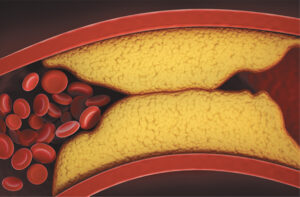 Cholesterol is a waxy, fat-like substance found in every cell of the body. It plays a crucial role in building cell membranes, producing hormones like estrogen and testosterone, and synthesizing Vitamin D. While cholesterol is essential for various bodily functions, high levels of certain types of cholesterol can pose significant health risks, including heart disease and stroke. It’s important to understand the intricacies of cholesterol, including the different types. By understanding cholesterol and what it is, you can determine its potential health risks and ways to maintain safe and healthy levels.
Cholesterol is a waxy, fat-like substance found in every cell of the body. It plays a crucial role in building cell membranes, producing hormones like estrogen and testosterone, and synthesizing Vitamin D. While cholesterol is essential for various bodily functions, high levels of certain types of cholesterol can pose significant health risks, including heart disease and stroke. It’s important to understand the intricacies of cholesterol, including the different types. By understanding cholesterol and what it is, you can determine its potential health risks and ways to maintain safe and healthy levels.
What is Cholesterol?
Cholesterol is carried through the bloodstream by lipoproteins, which are essentially a combination of fats (lipids) and proteins. There are two primary types of lipoproteins that carry cholesterol:
1. Low-Density Lipoprotein (LDL): Often referred to as “bad” cholesterol, LDL cholesterol is considered harmful because it can lead to the buildup of plaque in the arteries, causing atherosclerosis—a condition characterized by narrowed and hardened arteries. You want your LDL cholesterol to be low.
2. High-Density Lipoprotein (HDL): Known as “good” cholesterol, HDL cholesterol helps remove LDL cholesterol from the arteries and transport it to the liver for disposal. High levels of HDL are associated with a lower risk of heart disease.
Tip: Remember that LDL cholesterol is bad by thinking of the “L” for low, while HDL is good with the “H” for high.
Health Risks Associated with High Cholesterol Levels
Elevated levels of LDL cholesterol are a major risk factor for heart disease and stroke. When LDL cholesterol builds up in the walls of arteries, it can form plaque, which narrows the arteries and restricts blood flow. This increases the risk of blood clots, heart attacks, and strokes. Additionally, high levels of triglycerides, another type of fat found in the blood, can also contribute to cardiovascular disease.
Here are some of the primary health risks associated with high cholesterol levels:
1. Atherosclerosis: The buildup of plaque in the arteries can lead to atherosclerosis, a condition that restricts blood flow and increases the risk of heart attack and stroke.
2. Heart Disease: High cholesterol levels are a significant risk factor for coronary artery disease, which occurs when plaque builds up in the arteries that supply blood to the heart muscle.
3. Stroke: Blocked or narrowed arteries due to plaque buildup can impede blood flow to the brain, increasing the risk of stroke.
4. Peripheral Artery Disease (PAD): Atherosclerosis can also affect arteries outside of the heart and brain, leading to PAD, which causes reduced blood flow to the limbs, particularly the legs. This is a common risk factor for people who also suffer from diabetes.
Maintaining Healthy Cholesterol Levels
Managing cholesterol levels is crucial for reducing the risk of heart disease and stroke. Here are some strategies to help maintain healthy cholesterol levels:
1. Healthy Diet: Adopting a diet low in saturated and trans fats can help lower LDL cholesterol levels. Instead, focus on consuming foods rich in unsaturated fats, such as avocados, nuts, seeds, and olive oil. Increasing dietary fiber intake from fruits, vegetables, and whole grains can also help lower cholesterol levels.
2. Regular Exercise: Engaging in regular physical activity can help raise HDL cholesterol levels and lower LDL cholesterol levels. Aim for at least 150 minutes of moderate-intensity aerobic exercise, such as brisk walking or cycling, each week.
3. Maintain a Healthy Weight: Being overweight can contribute to elevated cholesterol levels. Losing excess weight through a combination of diet and exercise can help improve cholesterol levels.
4. Quit Smoking: Smoking can lower HDL cholesterol levels and damage the walls of blood vessels. Quitting smoking can help improve cholesterol levels and overall cardiovascular health.
5. Limit Alcohol Consumption: Excessive alcohol intake can raise triglyceride levels and contribute to weight gain. Limit alcohol consumption to moderate levels, which is defined as up to one drink per day for women and up to two drinks per day for men.
6. Medication: In some cases, lifestyle changes alone may not be sufficient to lower cholesterol levels adequately. In such instances, healthcare providers may prescribe cholesterol-lowering medications.
Manage Cholesterol Levels for Better Health
Cholesterol plays a vital role in various bodily functions, but elevated levels of LDL cholesterol can significantly increase the risk of heart disease and stroke. Managing cholesterol levels through lifestyle modifications, including diet and exercise, is essential for reducing the risk of cardiovascular disease. Additionally, it’s important to work with a primary care provider to establish a wellness plan to monitor and manage your cholesterol. Contact a VIPcare provider today and start your journey to lower cholesterol and Better Health! Call 239-747-7202 to schedule your appointment.
239-747-7202
www.getvipcare.com
20291 Summerlin Rd, Ste 105
Fort Myers, FL 33908
 Central Florida Health and Wellness Magazine Health and Wellness Articles of the Villages
Central Florida Health and Wellness Magazine Health and Wellness Articles of the Villages



